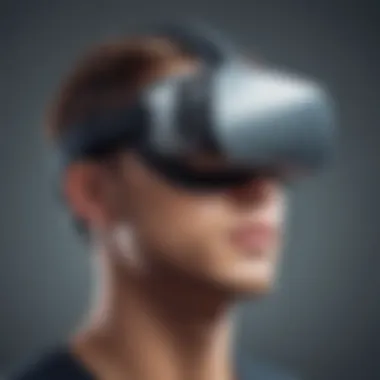Unveiling the Intriguing Universe of 3D Computer Graphics: Evolution, Applications, and Future Trends


Overview of 3D Computer Graphics
3D computer graphics, a captivating domain where art and technology converge, have seen remarkable evolution, unveiling a plethora of applications and paving the path for future trends. The multidimensional nature of 3D graphics allows for immersive visual experiences across various industries, from gaming and film production to architecture and virtual reality.
Best Practices in 3D Graphic Design
For those delving into 3D graphic design, adhering to industry best practices is paramount. These encompass meticulous attention to detail, thorough understanding of software capabilities, and consistent exploration of creative techniques. Maximizing efficiency and productivity involves maintaining a robust workflow, leveraging the latest tools and technologies, and staying updated on emerging trends in the field. To avoid common pitfalls, designers should be cautious of overcomplicating projects, neglecting proper rendering processes, and underestimating the importance of lighting and texture in achieving realistic visuals.
Case Studies in 3D Graphics
The realm of 3D computer graphics is enriched with compelling case studies showcasing successful implementation across diverse applications. From high-end visual effects in blockbuster films to precise architectural renderings for real estate projects, these instances highlight the transformative power of 3D design. Lessons learned from experienced practitioners underscore the significance of collaboration, innovation, and adaptability in achieving exceptional outcomes. Insights shared by industry experts shed light on the evolving landscape of 3D graphics, emphasizing the importance of continuous learning and experimentation.
Latest Trends and Innovations in 3D Design
As technology advances, the world of 3D design continues to witness exciting developments and innovations. From enhanced rendering techniques and realistic simulations to the integration of artificial intelligence for streamlined workflows, the future of 3D graphics holds immense promise. Current industry trends focus on accessibility, scalability, and sustainability, driving the demand for eco-friendly solutions and cloud-based rendering services. Forecasts hint at disruptive technologies and groundbreaking approaches that will redefine the boundaries of visual storytelling and immersive experiences.
How-To Guides and Tutorials for 3D Modeling
Navigating the realm of 3D modeling requires comprehensive how-to guides and hands-on tutorials tailored for both beginners and advanced users. These resources offer step-by-step instructions on software utilization, modeling techniques, texturing, lighting, and animation. Practical tips and tricks shared by seasoned professionals enhance the learning curve and equip enthusiasts with the skills needed to craft stunning 3D creations. Embracing tutorials as a learning tool encourages experimentation, fosters creativity, and empowers individuals to push the boundaries of their artistic endeavors in the realm of 3D computer graphics.
Introduction to 3D Computer Graphics
In this article, we embark on a journey through the captivating realm of 3D computer graphics, a field that beautifully marries art with cutting-edge technology. Exploring the evolution, applications, and future trends of 3D graphics, we aim to provide a valuable resource for tech enthusiasts and professionals looking to delve deeper into this fascinating domain.
Understanding the Basics
The Concept of 3D Modeling
Diving into the intricacies of 3D modeling, we unravel the essence of creating three-dimensional digital representations. This fundamental aspect forms the backbone of 3D computer graphics, allowing for the development of lifelike objects and environments in virtual space. The versatility and realism achievable through 3D modeling make it a preferred choice in various industries, promising unparalleled visual experiences. However, while empowering creativity, the complexity of 3D modeling poses challenges in terms of mastering the required skills and tools.
Rendering Techniques
Exploring the realm of rendering techniques, we unveil the methodologies behind transforming 3D models into visually stunning images. This crucial process significantly enhances the final output by simulating lighting, shadows, and textures, adding depth and realism to digital creations. The efficiency and realism achieved through advanced rendering algorithms make them indispensable in achieving high-quality graphics. Nevertheless, the computational intensity of rendering techniques can often demand significant processing power and time.
Importance of Lighting and Shading


Delving into the significance of lighting and shading, we illuminate the pivotal role these elements play in creating believable and visually striking 3D visuals. Effective lighting techniques can imbue digital scenes with mood, atmosphere, and realism, while shading enhances texture and defines object surfaces. The balance between light and shadow not only influences the overall aesthetic appeal but also communicates emotions and narratives within the visual content. Despite their critical role, mastering lighting and shading techniques requires a deep understanding of principles such as color theory and light behavior.
Historical Development
Origins of 3D Graphics
Tracing back to the origins of 3D graphics, we uncover the early inspirations and technological advancements that laid the foundation for the modern digital visualizations we witness today. The journey from simple wireframe models to complex photorealistic renderings showcases the evolution of 3D graphics as a powerful medium for artistic expression and technical innovation. Understanding the roots of 3D graphics provides valuable insights into the evolution of digital art and design.
Key Milestones in 3D Technology
Exploring the key milestones in 3D technology, we highlight the pivotal moments that revolutionized the way we interact with digital imagery. From the introduction of 3D modeling software to the advent of GPU-accelerated rendering, each milestone has propelled the capabilities of 3D graphics to new heights. These advancements not only enhance the creative potential of artists and designers but also drive the practical applications of 3D technology across various industries.
Impact of CGI on Various Industries
Analyzing the impact of computer-generated imagery (CGI) on diverse industries, we unravel how CGI has reshaped visual storytelling, product design, and entertainment experiences. The seamless integration of CGI in movies, advertising, and virtual simulations has blurred the line between reality and imagination, unlocking limitless possibilities for creative expression and interactive engagement. However, the omnipresence of CGI raises ethical considerations regarding authenticity, representation, and the boundaries between virtual and physical realms.
Applications of 3D Computer Graphics
In this comprehensive exploration of the world of 3D computer graphics, delving into the applications opens up a realm of possibilities. The use of 3D computer graphics spans across various industries and sectors, revolutionizing the way we perceive and interact with digital content. From enhancing visual effects in movies to facilitating immersive experiences in virtual reality, the applications of 3D computer graphics are vast and impactful. This section will shed light on the importance of leveraging 3D graphics in different fields, highlighting the specific elements, benefits, and considerations that make them integral to modern technology and design.
Entertainment Industry
Role of 3D graphics in movies and animations
Understanding the role of 3D graphics in movies and animations is crucial in grasping the essence of visual storytelling in modern cinema. The infusion of 3D elements adds depth, realism, and creativity to narratives, pushing the boundaries of cinematic imagination. This section will delve into how 3D graphics revolutionize filmmaking, emphasizing their contribution to captivating audiences and creating visually stunning worlds. Exploring the unique features and advantages of integrating 3D graphics into the entertainment industry provides insights into why it remains a preferred choice for visualizing complex narratives.
Virtual reality and augmented reality experiences
Virtual reality and augmented reality have emerged as transformative technologies, reshaping the way we experience digital content and interact with virtual environments. Within the realm of 3D computer graphics, these immersive technologies play a pivotal role in blurring the lines between the real and virtual worlds. Unveiling the key characteristics and benefits of VR and AR experiences, this section uncovers the potential for creating interactive and engaging narratives that transcend traditional forms of entertainment.
Gaming industry innovations
The gaming industry stands at the forefront of technological innovation, continually pushing the boundaries of visual realism and gameplay. Incorporating 3D graphics into game development has revolutionized the gaming experience, offering players immersive worlds and lifelike characters. Exploring the unique features and advantages of 3D graphics in gaming sheds light on why it has become a cornerstone of modern game design, captivating audiences and setting new standards for interactive entertainment.
Technological Advancements in 3D Graphics
Technological advancements play a pivotal role in shaping the landscape of 3D computer graphics. In this article, we delve deep into the realm of technological progress within the field, focusing on key elements and considerations that drive innovation and creativity. From GPU acceleration to ray tracing, these advancements open up new possibilities and enhance the overall user experience.


GPU Acceleration
Role of Graphics Processing Units
Graphics Processing Units (GPUs) are instrumental in the acceleration of rendering processes in 3D graphics. Their parallel processing capabilities significantly boost the speed and efficiency of complex calculations, making them indispensable in high-performance computing tasks. The sheer processing power of GPUs enables real-time rendering, rapid prototyping, and fluid visual simulations, making them a popular choice among professionals in the industry. Despite their advantages, GPUs also have limitations in terms of energy consumption and heat generation, which must be carefully managed in this context.
Real-time Rendering Capabilities
Real-time rendering capabilities revolutionize the way visuals are generated in 3D graphics. By allowing immediate visualization of changes in a scene as they occur, real-time rendering enables artists and developers to iterate quickly and make dynamic adjustments. This feature is particularly beneficial in interactive applications, such as games and immersive simulations, where responsiveness is key. However, maintaining real-time rendering can be resource-intensive, requiring optimized code and hardware to deliver smooth performance without compromising visual quality.
Enhanced Graphical Performance
Enhanced graphical performance drives the pursuit of ever-higher resolutions, frame rates, and visual fidelity in 3D graphics. It encompasses improvements in texture mapping, lighting effects, and particle systems that contribute to more realistic and immersive environments. The quest for enhanced graphical performance pushes hardware and software developers to innovate, introducing new techniques and algorithms to push the boundaries of what is visually achievable. While enhanced graphical performance enhances the realism of digital content, it also poses challenges in terms of computational complexity and hardware requirements.
Ray Tracing
Simulation of Realistic Light Interactions
Ray tracing technology simulates the behavior of light in a manner that closely mimics reality. By tracing the path of individual rays of light and calculating their interactions with surfaces and materials, ray tracing produces highly realistic images with accurate reflections, refractions, and shadows. This level of fidelity is essential in applications where visual authenticity is paramount, such as in architectural visualization and product design. However, the computational demands of ray tracing can be intensive, requiring significant processing power to achieve real-time performance.
Improvements in Visual Quality
The constant pursuit of improvements in visual quality drives innovation in 3D graphics. Whether through higher-resolution textures, advanced shading models, or sophisticated anti-aliasing techniques, enhancing visual quality aims to deliver a more immersive and stunning visual experience. These developments benefit a range of industries, from film production to virtual prototyping, by elevating the level of realism and detail in digital content. Yet, the challenge lies in balancing visual fidelity with performance efficiency, as pushing the boundaries of quality often comes at the cost of increased computational resources.
Integration in Gaming and Movie Production
Ray tracing's integration into gaming and movie production has revolutionized the creation of digital content. By providing unparalleled realism and lighting effects, ray tracing elevates the visual storytelling capabilities of filmmakers and game developers. Its ability to simulate complex lighting scenarios and atmospheric effects enhances the overall immersion and cinematic quality of rendered scenes. However, integrating ray tracing into real-time applications demands optimization and resource management to ensure smooth performance on consumer hardware without compromising artistic vision.
Future Trends and Innovations
In this section, we delve deep into the realm of future trends and innovations within the field of 3D computer graphics. It is imperative to comprehend the significance of staying abreast of the latest advancements in technology to remain competitive and relevant in this dynamic industry. By exploring the upcoming trends, we can anticipate the direction in which 3D graphics is heading, allowing us to adapt and innovate accordingly. Keeping a pulse on emerging technologies is vital for tech professionals and enthusiasts alike to maintain a cutting-edge approach.
Immersive Experiences
Advancements in VR and AR Technologies
The advancements in virtual reality (VR) and augmented reality (AR) technologies mark a pivotal shift in how we interact with and experience digital content. VR technology immerses users in a simulated environment, creating a sensory-rich experience that can range from entertainment to practical applications such as training simulations. On the other hand, AR overlays digital information onto the real world, enhancing our perception of reality. The versatility and depth of user engagement offered by VR and AR technologies make them attractive tools for enhancing user experiences and pushing the boundaries of creativity.


Interactive Storytelling Tools
Interactive storytelling tools revolutionize the way narratives are crafted and consumed, enabling users to become active participants in the storytelling process. These tools empower creators to develop nonlinear narratives, branching storylines, and interactive elements that heighten user engagement. By blurring the line between audience and storyteller, interactive storytelling tools bring a new dimension to traditional storytelling forms, fostering immersive and personalized experiences.
Haptic Feedback Integration
Haptic feedback integration adds a tactile dimension to virtual experiences, enabling users to perceive and interact with digital environments through touch. By simulating sensations such as texture, vibration, and force feedback, haptic technology enhances the sense of presence and realism in virtual interactions. This integration not only improves user immersion but also opens up new possibilities for enhancing accessibility, gaming experiences, and virtual training scenarios.
AI and Machine Learning
Automated 3D Content Generation
Automated 3D content generation streamlines the production process by using algorithms and machine learning to create 3D models and assets efficiently. This approach reduces manual labor, accelerates production timelines, and enhances scalability in content creation. The ability of automated systems to generate diverse and complex 3D content opens up new creative possibilities while optimizing workflow efficiencies.
AI-driven Character Animation
AI-driven character animation leverages artificial intelligence to automate and enhance the animation process, delivering lifelike movements and expressions to digital characters. By analyzing motion data and learning complex behaviors, AI algorithms can generate nuanced animations that would be challenging to achieve manually. This advanced technology not only saves time and resources but also elevates the quality and realism of character performances in various media contexts.
Enhanced Visual Effects Creation
Enhanced visual effects creation involves the use of AI and machine learning to empower artists and designers in producing stunning visual effects for films, games, and other digital content. By automating repetitive tasks, predicting design outcomes, and optimizing visual elements, AI-enhanced tools streamline the creative workflow and enable artists to focus on artistic expression. The synergy between AI and visual effects creation leads to visually captivating and compelling digital experiences for audiences worldwide.
Challenges and Ethical Considerations
In the realm of 3D computer graphics, delving into the Challenges and Ethical Considerations holds paramount importance. As technology advances, the ethical considerations surrounding content creation become increasingly complex and vital. Professionals and enthusiasts in the tech industry must navigate issues like data privacy, authenticity of visual content, and potential security risks. Addressing these challenges ensures the integrity and trustworthiness of 3D graphic design practices, safeguarding against ethical dilemmas and potential hazards.
Content Authenticity
Impact of deepfakes on trust
The Impact of deepfakes on trust within the context of 3D computer graphics is a critical discussion point. Deepfakes, which are digitally manipulated media often created through AI algorithms, pose a significant threat to the credibility and authenticity of visual content. By exploring the intricate nature of deepfake technology and its implications on trust within the digital landscape, this article sheds light on the importance of ensuring genuine and trustworthy 3D graphic material. Emphasizing the detrimental effects of deepfakes on trust underscores the need for vigilance and verification in content creation processes, amplifying the significance of maintaining authenticity in 3D designs.
Measures to prevent misinformation
In the domain of 3D computer graphics, implementing Measures to prevent misinformation is pivotal for upholding the reliability and accuracy of visual content. Various strategies, such as incorporating watermarking techniques, enhancing verification processes, and promoting transparency in content sources, play a crucial role in mitigating the dissemination of misleading or false information. By elucidating the importance of proactive measures to counter misinformation in 3D graphics, this article advocates for stringent protocols and ethical standards, ensuring that viewers can trust the visual material they engage with.
Ethical use of manipulated visuals
The Ethical use of manipulated visuals is a significant aspect to consider in the creation and dissemination of 3D graphic content. Ethical dilemmas may arise when utilizing manipulated visuals for artistic expression, entertainment, or informational purposes. By exploring the ethical implications of altering visuals through digital means, this article encourages ethical decision-making and responsible usage of manipulated visuals in 3D design practices. Assessing the ethical considerations related to manipulating visuals fosters a deeper understanding of the impact of digital alterations on audience perception and reception of 3D graphic artistry.
Privacy and Security Concerns
In the constantly evolving landscape of 3D computer graphics, Privacy and Security Concerns are central to ensuring the protection of sensitive data and prevention of potential cyber threats. Addressing issues such as data privacy in virtual environments, security implications of VR simulations, and cybersecurity risks in 3D content creation is essential for maintaining the integrity and safety of digital assets. By highlighting the key characteristics and implications of these privacy and security concerns, this article underscores the significance of implementing robust security measures and ethical practices in 3D graphic design environments, safeguarding against breaches and vulnerabilities. Analyzing the unique features and challenges associated with privacy and security in 3D content creation provides readers with a comprehensive understanding of the proactive steps needed to foster a secure and trustworthy digital ecosystem.



